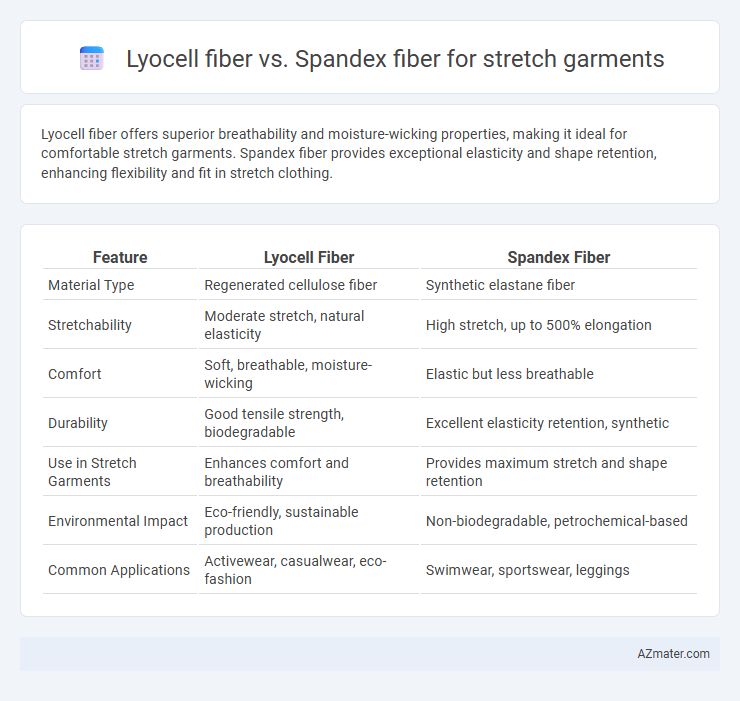Lyocell fiber offers superior breathability and moisture-wicking properties, making it ideal for comfortable stretch garments. Spandex fiber provides exceptional elasticity and shape retention, enhancing flexibility and fit in stretch clothing.
Table of Comparison
| Feature | Lyocell Fiber | Spandex Fiber |
|---|---|---|
| Material Type | Regenerated cellulose fiber | Synthetic elastane fiber |
| Stretchability | Moderate stretch, natural elasticity | High stretch, up to 500% elongation |
| Comfort | Soft, breathable, moisture-wicking | Elastic but less breathable |
| Durability | Good tensile strength, biodegradable | Excellent elasticity retention, synthetic |
| Use in Stretch Garments | Enhances comfort and breathability | Provides maximum stretch and shape retention |
| Environmental Impact | Eco-friendly, sustainable production | Non-biodegradable, petrochemical-based |
| Common Applications | Activewear, casualwear, eco-fashion | Swimwear, sportswear, leggings |
Overview of Lyocell and Spandex Fibers
Lyocell fiber is a biodegradable, eco-friendly rayon made from wood pulp, known for its softness, breathability, and moisture-wicking properties, making it ideal for comfortable stretch garments. Spandex fiber, a synthetic elastomeric fiber, provides exceptional elasticity and recovery, enabling garments to stretch significantly while maintaining shape and durability. Combining Lyocell with Spandex enhances stretch fabric performance by merging natural comfort with superior stretch and resilience.
Fiber Composition and Manufacturing Processes
Lyocell fiber is a regenerated cellulose fiber made from sustainably sourced wood pulp, produced through a closed-loop solvent spinning process that minimizes environmental impact, while Spandex fiber, also known as elastane, is a synthetic polymer composed of polyurethane segments synthesized through a chemical reaction called step-growth polymerization. Lyocell offers excellent breathability and moisture-wicking properties due to its cellulose composition, whereas Spandex provides exceptional elasticity and recovery owing to its segmented polyurethane molecular structure. In stretch garments, Lyocell is often blended with Spandex to combine natural comfort and sustainability with high stretch and shape retention.
Environmental Impact Comparison
Lyocell fiber is derived from sustainably sourced wood pulp using a closed-loop process that recycles water and solvents, resulting in minimal environmental pollution and biodegradability. Spandex fiber, primarily made from non-renewable petroleum-based polyurethane, involves energy-intensive manufacturing and produces non-biodegradable waste contributing to microplastic pollution. Choosing Lyocell over Spandex for stretch garments significantly reduces ecological footprint due to its renewable origins and eco-friendly production methods.
Mechanical Properties: Strength and Flexibility
Lyocell fiber exhibits high tensile strength and excellent moisture retention, making it durable and resistant to stretching out in stretch garments, whereas Spandex fiber provides superior elasticity and exceptional stretch recovery, crucial for maintaining garment shape. The strength of Lyocell contributes to garment longevity by withstanding mechanical stress, while Spandex enhances flexibility with elongation up to 500%, allowing dynamic movement without deformation. Combining Lyocell's mechanical strength with Spandex's flexibility optimizes stretch garments for both durability and comfort.
Stretch and Recovery Capabilities
Lyocell fiber offers moderate stretch with excellent wrinkle resistance but exhibits limited recovery compared to Spandex fiber, which provides superior stretch and almost full recovery, making it ideal for high-performance stretch garments. Spandex can elongate up to 500% without permanent deformation, while Lyocell stretch typically ranges between 10-20%, favoring comfort over extreme elasticity. Combining Lyocell's moisture-wicking properties with Spandex's exceptional elasticity enhances garment fit and durability for activewear and athleisure applications.
Moisture Management and Comfort
Lyocell fiber offers superior moisture management compared to Spandex, as its natural cellulose structure efficiently absorbs and releases moisture, keeping the skin dry and comfortable. Spandex, while providing excellent stretch and shape retention, lacks effective moisture-wicking properties, often resulting in a damp and less breathable feel during extended wear. Combining Lyocell with Spandex in stretch garments enhances overall comfort by balancing moisture control with flexibility and support.
Durability and Wear Resistance
Lyocell fiber offers excellent durability due to its high tensile strength and moisture-wicking properties, making it resistant to tearing and abrasion in stretch garments. Spandex fiber, known for its exceptional elasticity and recovery, provides superior stretch and shape retention, but it can degrade over time with exposure to heat, sweat, and UV light. Combining Lyocell with Spandex enhances wear resistance by balancing the natural fiber's durability with synthetic stretch, ensuring longer-lasting comfort and performance.
Applications in Stretch Garments
Lyocell fiber offers excellent moisture absorption and breathability, making it ideal for stretch garments requiring comfort and eco-friendly performance. Spandex fibers provide superior elasticity and shape retention, essential for activewear and performance stretch clothing that demand maximum stretch and recovery. Combining Lyocell with Spandex produces durable, flexible fabrics well-suited for athleisure, yoga wear, and fitted apparel.
Cost and Market Availability
Lyocell fiber offers moderate cost and excellent breathability but is less available in stretch garment applications compared to the highly elastic and widely available Spandex fiber, which remains cost-effective for high-stretch needs. Spandex dominates the market with its superior stretch recovery and durability, driving large-scale production and accessible pricing across apparel sectors. The choice between Lyocell and Spandex often depends on budget constraints and performance demands, with Spandex preferred for affordability and mass-market availability in stretch fabrics.
Consumer Preferences and Future Trends
Lyocell fiber offers superior breathability, moisture management, and eco-friendly sustainability, which appeals to consumers seeking comfort and environmental responsibility in stretch garments. Spandex fiber provides exceptional elasticity and shape retention, making it preferred for activewear and form-fitting apparel where stretch recovery is crucial. Future trends indicate a growing demand for hybrid textiles combining Lyocell's natural feel with Spandex's stretch performance to meet consumer preferences for comfort, durability, and sustainable fashion.

Infographic: Lyocell fiber vs Spandex fiber for Stretch garment
 azmater.com
azmater.com